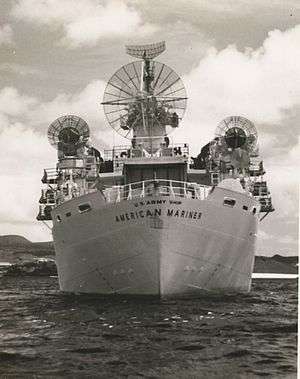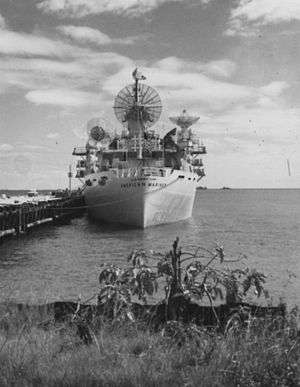USAS American Mariner
 USAS American Mariner | |
| History | |
|---|---|
| Name: | USAS American Mariner |
| Owner: | ARGMA, U.S. Army (1958–1963) |
| Operator: | Mathiesen Tankers Ind. |
| Route: | Atlantic and Pacific Missile Ranges |
| Ordered: | 1941 as SS George Calvert |
| Builder: | Bethlehem-Fairfield Shipyard, Baltimore, Maryland |
| Laid down: | 15 August 1941 |
| Launched: | 30 December 1941 |
| In service: | 18 June 1958 (U.S. Army) |
| Out of service: | 31 December 1963 (U.S. Army) |
| Reclassified: | Transferred to U.S. Air Force as USAFS American Mariner (T-AGM-12) on 1 January 1964 |
| Refit: | Brooklyn, New York; Baltimore, Maryland; San Juan, Puerto Rico; San Pedro, California; Dakar, Senegal, and Cape Town, South Africa. |
| Homeport: | none |
| Nickname(s): | "Ancient Mariner" |
| Fate: | Scuttled for use as a target, October 1966 |
| General characteristics | |
| Class and type: |
|
| Displacement: | 10,650 tons (full load) |
| Length: | 441 ft (134 m) |
| Beam: | 56 ft (17 m) |
| Draft: | 24–26 feet during operations |
| Propulsion: |
|
| Speed: | 8–10 knots |
| Range: | 23,000 miles (37,000 km) |
| Endurance: | 45 days at sea (typical) |
| Capacity: | 9,507 barrels bunker C |
| Complement: |
|
| Sensors and processing systems: |
|
| Armament: | None |
The USAS American Mariner was a United States Army research vessel from January 1959 to 30 September 1963. She was originally assigned to the DAMP Project by the Advanced Research Projects Agency (ARPA) to attempt to collect radar signature data on incoming intercontinental ballistic missiles in the Caribbean, the South Atlantic Ocean, and the Indian Ocean. Her initial operations involved providing radar track on the Atlas missile, which was under development at the time. Subsequently, she provided track on other types of missiles as they proceeded through their development and operational stages.
Laid down in 1941 as the Liberty ship SS George Calvert (MC #20), she first saw service as the United States Coast Guard training ship TS American Mariner, as which she served until 1953, when she was placed in reserve. After her Army career, she was transferred to the United States Air Force on 1 October 1963, and was redesignated the USAFS American Mariner. After Air Force service, she was transferred to the United States Navy and designated the USNS American Mariner (T-AGM-12). In 1966 she was scuttled in shallow water in the Chesapeake Bay about 5 nautical miles (9 km) north west of Ewell, Smith Island, Maryland, for use for a target ship.
She appears to have been the only ship to have served in the U.S. Coast Guard, the U.S. Army, the U.S. Air Force, and the U.S. Navy after being built for service with the United States Merchant Marine.
History
Initial construction and early history

The keel for SS George Calvert' (build number 2007/MC Hull 20) was laid on 15 August 1941 in the Bethlehem-Fairfield Shipyard, Baltimore, Maryland.[1] She was launched 30 December 1941, sponsored by Miss Margaret E. Voss.[1] At 65.4% complete, she was transferred for conversion to a training vessel.[1] She had additional superstructure added to accommodate more personnel and was renamed the TS American Mariner.
The conversion was completed 10 March 1943 and she was delivered to the War Shipping Administration – Division of Training.[1] She then served the U.S. Coast Guard as a cadet training ship, together with the SS American Seaman and the SS American Sailor. After this service to the U.S. Coast Guard she was placed in a standby status on the Hudson River as she was no longer needed for the war effort. In 1950 she was transferred to the United States Merchant Marine Academy in Kings Point, New York for use as a training ship.[1] She was returned to the Hudson River reserve fleet on 9 December 1953.[1]
Conversion to Missile Tracking Ship

On 18 June 1958 she was removed from the Hudson River, and transferred to the U.S. Army.[1] and outfitted in early 1959 with state-of-the-art C-band-frequency narrow-beam radar tracking equipment for the Army.
The ship, redesignated USAS American Mariner, was then assigned to Mathiesen Tankers Industry, which provided the crew for the ship, and to RCA Service Company, which provided the necessary radar equipment and technical personnel, and Barnes Engineering Company, which provided the necessary optical equipment and technical personnel for the ship's new DAMP Project assignment.
Atlantic Missile Test operations
During her years on the DAMP Project the USAS American Mariner operated various types of long-distance, narrow-beam radars to gather data on intercontinental ballistic missiles. This period (1959–1963) represented the infancy of the "space race" and ballistic missiles in particular, and it was necessary, for security reasons, for the U.S. to determine if missiles could be identified in space (from a radar signature, for example) before they re-entered the atmosphere.
Hopefully, for it was not known at the time, various types of missiles would provide different radar signatures. This would be important for identifying American missiles from those of other countries. This, if such data could be provided and fed into the computers of that era, would lead to the development of American anti-ballistic-missile defense systems, such as Nike-Zeus, which was a part of Project Nike.
During her Atlantic Ocean operations, the USAS American Mariner gathered radar signature data of ballistic missiles launched by the Cape Canaveral Air Force Station into the Broad Ocean Area located off of the coast of Florida, as well as intercontinental ballistic missiles launched into the South Atlantic Ocean near Ascension Island. Collection of signature data of each missile type was important during the in-flight portion of the missile. This was especially true during the missile re-entry as the missile descended through the atmosphere to its designated target point in the ocean, which is where the USAS American Mariner was usually positioned with its narrow-beam radars activated and searching in order to "lock on" to the missile.

Tracking of missiles during re-entry was often difficult since, at times, the missile contained decoy pods which would be ejected during re-entry to deceive tracking personnel at the target test location. As a result, it was difficult to ensure that the vessel's radars were tracking the actual vehicle and not one of the decoys. The decoys were intended to deceive the "enemy" and not necessarily the test vessel's radars; however, those who designed the decoys needed to know how effective they actually were. All such data was very important at this critical time in early space and missile development during the early years of the "Cold War."
Pacific Missile Test operations
In the Pacific Ocean in 1962, the American Mariner gathered radar signature data of missiles launched during Operation Dominic atmospheric nuclear testing. The ship operated in the Johnston Island area and, during one major test, the nuclear event exploded in the upper atmosphere directly over the vessel in order to determine if the radars on the USAS American Mariner could track and identify missiles in the nuclear cloud.
While investigating reports of foreign missile testing in the North Pacific Ocean in November 1962, the USAS American Mariner became caught up in Typhoon Karen, which caused significant rolling, and some flooding, of the top heavy ship, which was quickly repaired.
After completing test operations in the Pacific Ocean, the USAS American Mariner returned to the Eastern Test Range in the Atlantic Ocean, by transiting the Panama Canal in January 1963.
Support of NASA
While in the Pacific Ocean, the USAS American Mariner was temporarily assigned in late September 1962 to NASA in support of NASA's Project Mercury. During Wally Schirra's MA-8 transits over the Pacific Ocean, the USAS American Mariner successfully provided radar track of the capsule. While assigned to this mission, all data provided by the ship was transmitted by unclassified methods in accordance with NASA mission principles.
Vessel Support

While performing her missile-tracking operations, the American Mariner was reprovisioned in various ports in both the Atlantic and Pacific Oceans:
In the Atlantic Ocean, shore-side support was generally provided at San Juan, Puerto Rico; Antigua Island; Chagaramus, Trinidad; Recife, Brazil; Monrovia, Liberia; Dakar, Senegal; and Cape Town, South Africa.
During Pacific Ocean operations, support, including logistics, mail, embarkation and transfer of technical personnel, occurred at Pearl Harbor, in Hawaii, at Midway Island, and at Johnston Island.
Vessel and equipment overhaul
Since the American Mariner remained at sea for approximately four years under U.S. Army service, the ship regularly required shipyard service on her hull and her electronic equipment.
Extensive shipyard overhauls and drydocking were conducted in Brooklyn, New York; Baltimore, Maryland; San Juan, Puerto Rico; Long Beach, California; Pearl Harbor, Hawaii and Dakar in Senegal, Africa. Extensive technical enhancements in equipment [28-foot-diameter (8.5 m) L-band and UHF-band radar dish installation] were conducted in Cape Town, South Africa with the assistance of local technical personnel.
Prior to participating in nuclear testing operations during the Spring and Fall of 1962 under Operation Dominic, the USAS American Mariner was outfitted at Pearl Harbor, Hawaii, with protective anti-radiation equipment, including emergency warning lights and a water spraying system that, when turned on during an atomic event, would cover the ship with a fine spray of water intended to remove and wash away nuclear contamination.
Retirement

The operations of the American Mariner, a radar-signature data gathering ship, was replaced, in mid-1964, by two U.S. Air Force ships, the H. H. Arnold and the H. S. Vandenberg, both Advanced Research Instrumentation Ships (ARIS) which gathered and provided metric data to the Air Force.
Fate
In October 1966, she was scuttled in shallow water with demolition charges by Navy Underwater Demolition Team #22. Settling upright in 20 feet (6.1 meters) of water, she appears to be merely anchored there. The hulk was used for target practice by naval aviators flying out of Naval Air Station Patuxent River, Maryland, until at least 1971.[1] Her hulk is still visible in the Chesapeake Bay, at 38°02′25″N 76°09′17″W / 38.04028°N 76.15472°WCoordinates: 38°02′25″N 76°09′17″W / 38.04028°N 76.15472°W, roughly midway between Point Lookout and Smith Island.
References
Further reading
- Hahn, Herbert Paul (1990). American Mariner: A Documentary Biography. Kings Point, NY: American Merchant Marine Museum Foundation. ISBN 1-879180-00-6.
External links
| Wikimedia Commons has media related to USNS American Mariner (T-AGM-12). |
- The Space Review
- NavSource Online: Ship Archive – USAS American Mariner – USAFS American Mariner – USNS American Mariner (T-AGM-12)
- American Mariner 1941
- MEASUREMENT OF ATMOSPHERIC ATTENUATION ABOARD USAS AMERICAN MARINER
- Ships of the Special Mission Force, Military Sea Transportation Service/Military Sealift Command 1958–2000
- Photo of American Mariner hulk
- American Mariner interior photographs – 25 April 2009
- American Mariner interior video – 25 April 2009